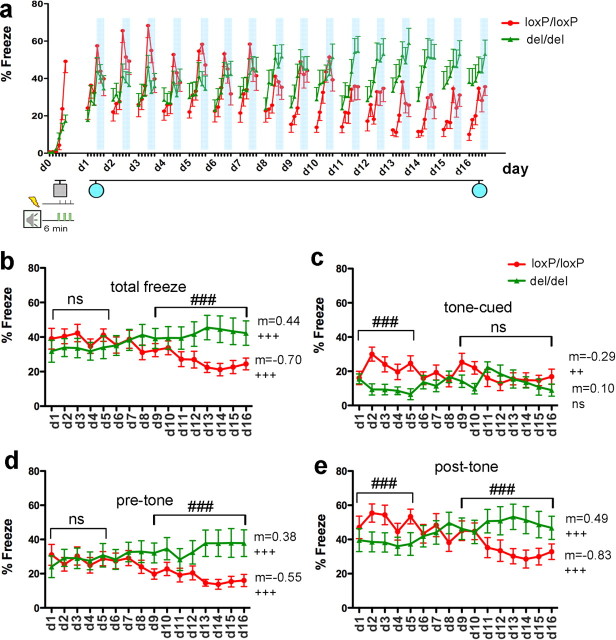Figure 4.
Extinction of auditory fear conditioning was abolished in mGluR5-deficient mice. a, Extinction of auditory fear conditioning. Mice were trained with three footshocks paired with tones at d0 in one context (gray square) and subsequently returned to a different context (blue circles) for 16 consecutive days. Extinction training on each day lasted 6 min, with one tone of 3 min presented during the final 3 min. Freezing was scored at 1 min intervals to compare within-session fear expression profiles between the two genotype groups (mGluR5del/del n = 14; mGluR5loxP/loxP n = 16). Time periods for the tone presentations were highlighted with blue bars (each represents 3 min). Gray square marked for the context for fear acquisition. Blue circles indicate the neutral context where extinction trainings were conducted. b, Total freezing in each day analyzed in 6 min block. Initially, mGluR5del/del mice (n = 14) showed slightly less freezing (F (1,140) = 3.86, p = 0.0513, d1–d5), but this freezing behavior was not diminished during the course of repeated tone presentations. In contrast, mGluR5loxP/loxP mice (n = 16) showed extinction of auditory fear conditioning upon repeated daily exposure, resulting in less freezing in the second half of testing (F (1, 224) = 32.64, p < 0.001, d9–d16). Overall, day–genotype interaction was significant (F (15,420) = 7.52, p < 0.0001). Post-test detected significant trend of fear extinction in mGluR5loxP/loxP mice (slope = −0.70, p < 0.0001) and significant trend of increase in fear in mGluR5del/del mice (slope = 0.44, p < 0.0001). c, Extinction of tone-cued freezing. At the onset, tone-cued freezing was less in mGluR5del/del mice (F (1,140) = 29.57, p < 0.0001, d1–d15). Near the completion of the test, tone-cued freezing amounts were similar between the two groups (F (1,224) = 2.16, p = 0.14, d9–d16). Two-way ANOVA showed a significant day–genotype interaction from d1 to d16 (F (15,420) = 2.80, p = 0.0004). Post-test for linear trend detected significant trend of decrease of fear in mGluR5loxP/loxP mice (slope = −0.29, p < 0.0031) but not in mGluR5del/del mice (slope = 0.11, p = 0.23). d, Pretone freezing analyzed in 3 min block. Although both groups displayed similar amounts of freezing in the early and middle sessions of training (d1–d9), mGluR5del/del mice froze more in the late sessions (d9–d16) (F1, 224 = 40.15, p < 0.0001). Two-way ANOVA showed a significant day–genotype interaction from d1 to d16 (F (15,420) = 4.13, p < 0.0001). Post-test for linear trend detected significant trend of fear reduction in mGluR5loxP/loxP mice (slope = −0.55, p < 0.0001) and a significant trend of fear increase in mGluR5del/del mice (slope = 0.38, p < 0.0001). e, Post-tone freezing analyzed in 3 min block. Initially, post-tone freezing was less in mGluR5del/del mice (F (1,140) = 12.87, p = 0.0005, d1–d15). However, mGluR5del/del mice froze more in the end (F (1,224) = 20.2, p < 0.0001, d9–d16). Two-way ANOVA showed a significant day–genotype interaction from d1 to d16 (F (15,420) = 7.50, p < 0.0001). A significant trend of fear reduction in mGluR5del/del mice (m = −0.83, p < 0.0001) and a significant trend of fear increase in mGluR5del/del mice (m = 0.49, p < 0.0001) were detected. Data are presented as SEM (### p < 0.001 for two-way ANOVA). (Linear slope is denoted by “m”; ++ p < 0.01 and +++ p < 0.001 for ANOVA post-test for linear trend). ns, Not significant.

